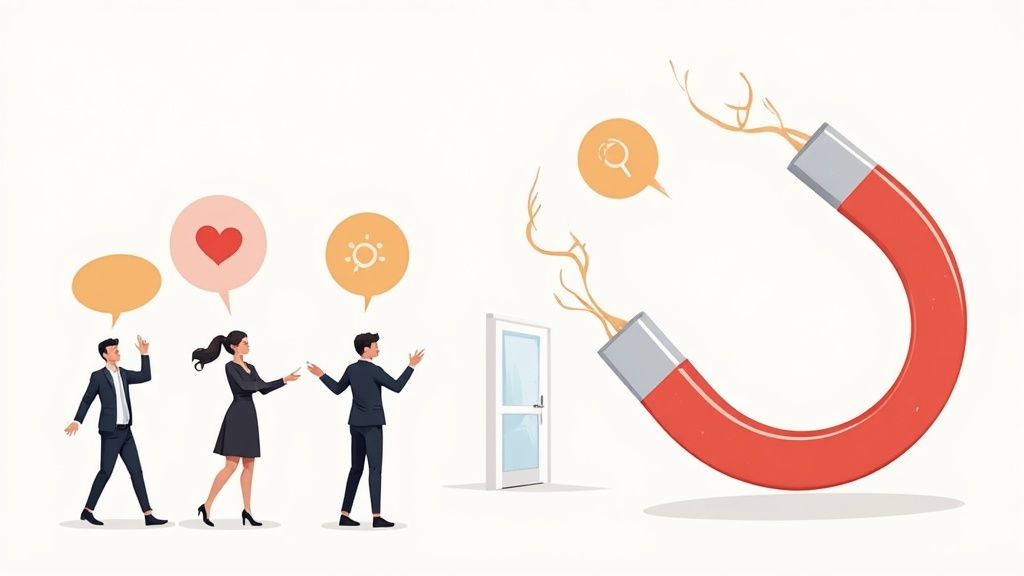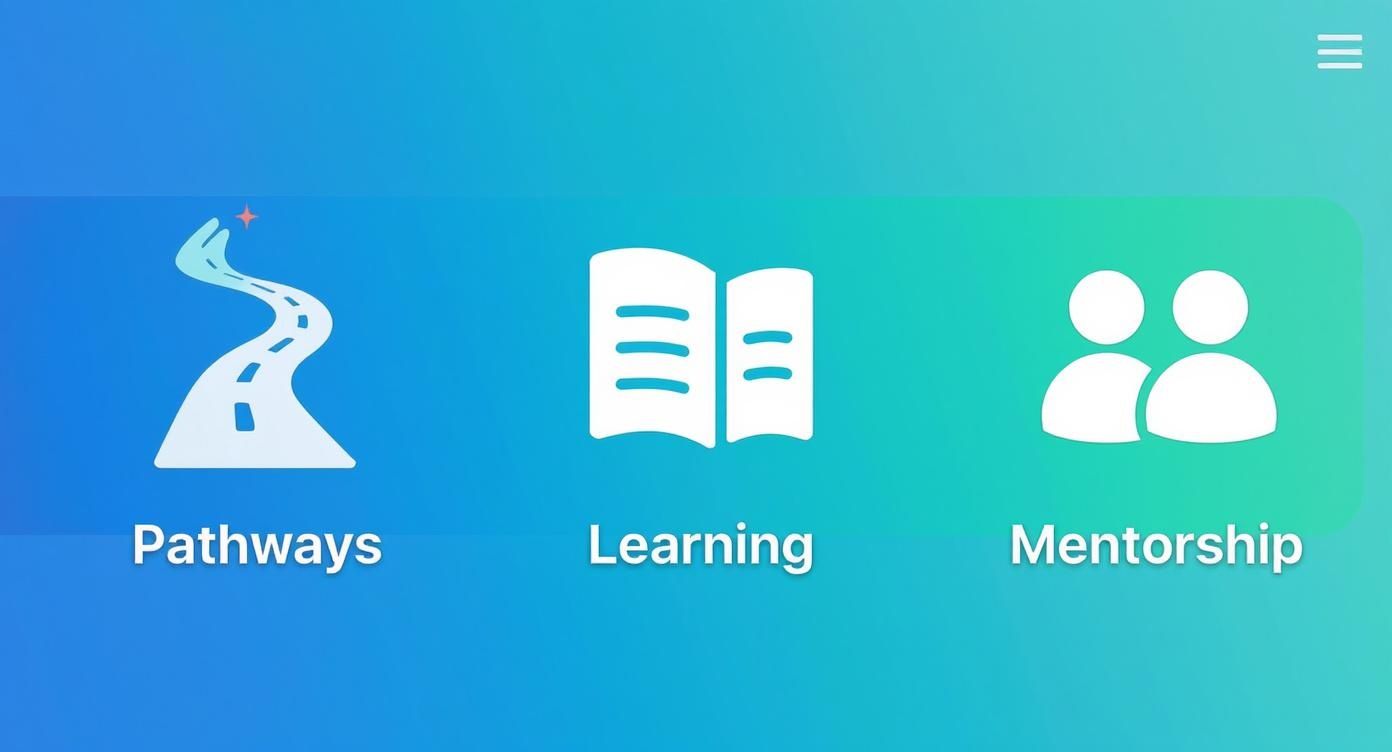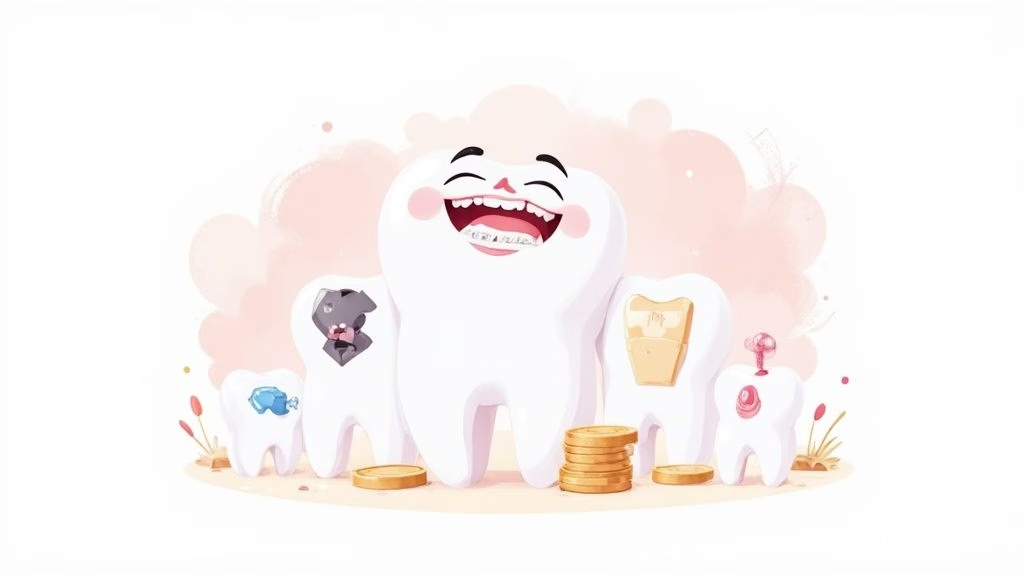How to Improve Employee Retention: Proven Strategies

Improving employee retention isn’t just an HR problem—it’s a direct threat to your bottom line. It’s about building a magnetic culture, genuinely investing in your people’s careers, and offering benefits that actually make a difference in their lives.
When you get it right, you create an environment people simply don’t want to leave.
Why Employee Retention Matters for Your Business

High staff turnover is more than an inconvenience; it’s a silent killer of resources, momentum, and morale. When a great employee walks out the door, you’re not just losing their daily output. You’re losing years of institutional knowledge, crucial client relationships, and the unique spark they brought to the team.
The financial hit is the most obvious part. The cycle of recruiting, hiring, and training a replacement is an expensive, time-consuming grind. To truly grasp why retention is so critical, you need to understand the hidden costs that are draining your business due to turnover. The sticker shock goes way beyond recruitment agency fees.
The True Cost of High Turnover
Think about the domino effect. Your best people are pulled away from their own work to screen CVs, sit in on interviews, and then hand-hold the new starter for weeks, if not months. Productivity inevitably dips while the new person finds their feet.
This isn’t a minor blip. In the UK, the national average staff turnover rate was 15% in Spring 2025. That’s a significant number, especially when you realise that replacing an employee typically costs a business between six to nine months of that person’s salary. It’s a staggering, often invisible, expense.
A stable, engaged workforce isn’t a luxury—it’s a competitive advantage. Companies that master employee retention consistently outperform their peers in customer satisfaction, innovation, and long-term profitability.
It’s More Than Just a Numbers Game
Beyond the balance sheet, a revolving door of staff poisons your company culture. It creates a sense of instability and quietly tells your remaining team that this might not be a place to build a career. That doubt can quickly lead to disengagement, even among your most loyal people.
On the flip side, businesses that make keeping their people a priority reap massive rewards:
- A Better Customer Experience: Seasoned employees have deep product knowledge and have built real trust with clients. This translates directly to better service and loyalty.
- A Culture of Innovation: When teams feel secure, they’re more willing to take smart risks, experiment, and share new ideas. That’s how you drive real progress.
- A Stronger Employer Brand: Low turnover is one of your best recruitment tools. Top talent actively seeks out companies known for stability and growth.
To give you a clearer picture, here’s a quick snapshot of the core pillars we’ll be diving into. Think of it as your cheat sheet for building a retention-focused strategy.
Quick Guide to Key Retention Drivers
| Strategy Pillar | Primary Goal | Key Actions |
| Onboarding | Make new hires feel welcome, capable, and connected from day one. | Structured 90-day plans, mentor programmes, regular check-ins, and clear introductions to company culture. |
| Career Development | Show employees a clear path for growth within the company. | Personal development plans, skills training, internal mobility opportunities, and leadership coaching. |
| Recognition | Ensure employees feel seen and valued for their contributions. | Peer-to-peer recognition platforms, performance bonuses, public praise, and celebrating key milestones. |
| Benefits & Well-being | Support the whole person, not just the employee. | Flexible working, comprehensive health benefits, generous leave policies, and mental health support resources. |
| Feedback Culture | Create a safe environment for open, two-way communication. | Regular one-to-ones, stay interviews, anonymous surveys, and acting on the feedback you receive. |
These pillars form the foundation of a workplace that not only attracts great talent but, more importantly, keeps it. This guide will give you the practical roadmap to put it all into action.
Build a Magnetic Culture People Refuse to Leave

Let’s be clear: a great company culture isn’t about the beanbags in the corner or the inspirational posters on the wall. It’s the invisible force that shapes how your team feels when they log on in the morning. It’s the difference between a job people merely tolerate and a career they’re genuinely passionate about.
Building this kind of magnetic culture is probably the most powerful thing you can do for retention. Why? Because it taps into the fundamental human needs of belonging, purpose, and feeling safe. When people feel truly valued and secure, they don’t just work harder; they become advocates for the business. But this kind of environment doesn’t just happen. It has to be built, brick by brick, through deliberate actions and honest communication.
Cultivate Genuine Transparency
Transparency is the bedrock of trust. Without it, even your best intentions can get twisted into rumours and anxiety, leading to a team that’s completely disengaged. Real transparency means sharing the ‘why’ behind business decisions, being upfront about challenges, and creating an environment where people can speak openly without fear.
For instance, if you’re shifting the company’s strategic focus, don’t just send out a memo. Get everyone together for a town hall. Have the leadership team explain the market conditions driving the change, what it means for different departments, and how each person’s role fits into the new picture. This simple act can transform a moment of uncertainty into a shared mission.
A Gallup study revealed something fascinating: companies where more employees had a ‘best friend’ at work saw 7% more engaged customers and 12% higher profit. A strong, connected culture isn’t just a nice-to-have; it’s a business imperative.
Fostering these connections can be as simple as encouraging informal chats. Something as straightforward as building a strong office coffee culture can make a huge difference in how people connect and collaborate.
Foster True Psychological Safety
Psychological safety is a bit of a buzzword, but the concept is vital. It’s the shared belief that you can take risks on a team without feeling embarrassed or punished. It’s having the freedom to ask a supposedly “silly” question, challenge a process that’s been in place for years, or admit you made a mistake. Without it, people go into self-preservation mode, and that’s a death sentence for creativity and real teamwork.
Leaders have an outsized role to play here. Their behaviour sets the tone for everyone else.
- Model Vulnerability: When a leader openly admits they don’t have all the answers or shares a past failure, it gives their team permission to be human, too.
- Encourage Dissent: In meetings, actively ask for different viewpoints. Try phrases like, “What are the risks I’m not seeing?” or “Does anyone have a completely different take on this?” It invites healthy debate.
- Respond Productively to Failure: When a project fails, the first question should be, “What did we learn?” not “Whose fault is it?” This encourages smart risk-taking instead of fearful inaction.
Live Your Values Every Day
Company values are completely meaningless if they just live on a plaque in the lobby. A magnetic culture is one where those values are demonstrated daily—from how managers give feedback to how the company navigates tough decisions. If “collaboration” is a core value, but every team operates in a silo, that hypocrisy will destroy trust in a heartbeat.
The trick is to connect your abstract values to concrete, everyday behaviours.
Here’s what that looks like in practice:
- Stated Value: “Customer Obsession”
- Value in Action: A junior support agent spots a recurring issue that a small product tweak could fix. Instead of getting tangled in red tape, she feels empowered to bring the solution directly to the product team, who actually listens and implements the change.
That’s how values become real. When people see that their actions truly align with what the company stands for, their sense of purpose deepens. And when that happens, they’re far more likely to stick around for the long haul.
Show People Their Future to Keep Them in the Present
When someone can’t picture their future with your company, you can bet they’re already picturing it somewhere else. Investing in real, tangible career growth isn’t just about a training budget; it’s one of the most powerful ways to build lasting loyalty.
It’s about proving to your team that you’re invested in their whole professional journey, not just the results they deliver this quarter. A dead-end role is a fast track to the exit, especially for your most driven and talented people.
Don’t Just Talk About Growth, Map It Out
One of the biggest sources of frustration for any employee is vagueness. Telling them “there’s room to grow” is meaningless without a map. You need to show them exactly what that growth looks like.
This means creating clear and transparent career pathways for different roles. This doesn’t need to be some rigid corporate ladder. Think of it more as a set of possible routes an employee can take, helping them navigate their own career within your business.
- Define what ‘good’ looks like at each stage: What specific skills, knowledge, and behaviours separate a junior from a mid-level person, or a mid-level from a senior expert? Write it down.
- Create paths for specialists, not just managers: Not everyone wants to manage a team. Make sure you have a clear path for individual contributors who want to become go-to experts in their field.
- Put the map in their hands: These pathways shouldn’t be locked away in an HR drive. They should be living documents, discussed openly and often in one-to-ones and performance chats.
When someone knows the exact skills they need to master to get to the next level, their development stops being a guessing game and becomes a shared goal.
Go Beyond the Occasional Training Day
A few one-off workshops a year won’t cut it. A truly effective learning and development (L&D) culture is woven into the day-to-day fabric of the business. It’s a continuous process. After all, a staggering 63% of UK workers who leave their jobs point to a lack of learning and advancement opportunities as a major reason.
Investing in your team’s skills is a direct investment in your company’s future. When people are learning and getting better at what they do, they’re more engaged, more creative, and far more likely to stick around.
This means offering a real variety of learning options that suit different people and their needs. Try to build a programme that includes:
- Mentorship schemes: Pairing up seasoned pros with newer team members is brilliant for passing on that hard-to-teach institutional knowledge and building strong internal connections.
- Targeted skills training: Offer focused training on the specific tools, software, or methods people actually use. This could be anything from advanced Excel wizardry to a formal project management qualification.
- Cross-departmental projects: Let people dip their toes into projects outside their usual team. It’s a great way to broaden their understanding of the business and help them uncover hidden talents or interests.
Make Growth a Visible Part of Your Culture
Creating these opportunities is only half the battle; you have to talk about them constantly. If your team doesn’t know what’s on offer, it’s as if the programmes don’t exist at all.
The current UK job market really drives this point home. With retention being a huge challenge in 2025 and almost half of UK workers (48%) thinking about quitting within the year, this is urgent. Companies that champion career development don’t just keep their people; they often outperform their rivals. Despite this, only about 10% of UK employees say they feel truly engaged at work, which screams of a need for better growth opportunities. You can dig into the full research about these workplace trends to get the complete picture.
Make career progression visible by celebrating it. When someone gets a promotion, don’t just send a bland all-staff email. Share their story, talk about the skills they built to get there, and show others what’s possible. When a team gets a new certification, shout about it. These small acts send a powerful message: this is a place where you can build a career, not just do a job.
Rethink Your Compensation and Benefits Package
While paying your team a fair, competitive salary is the absolute baseline for keeping them, it’s no longer the silver bullet for loyalty. In today’s market, the real differentiator is a benefits package that shows you genuinely understand and support your employees’ lives, both in and out of the office.
A generic, one-size-fits-all approach to benefits just doesn’t cut it anymore. People now expect flexibility and perks that add real value to their lives, from robust wellness programmes to unique offerings that reflect your company’s values. Getting this right sends a clear message: we care about you as a whole person, not just a name on the payroll.
Look Beyond the Pay Cheque
Salary is what gets people in the door, but a thoughtful benefits package is what convinces them to stay for the long haul. It demonstrates a much deeper investment in their wellbeing, financial security, and work-life balance.
This is where you can get creative and really stand out. Instead of a standard, often costly, corporate dental plan that limits choices, you could offer a more modern solution. Providing a benefit like Toothfairy gives your team affordable and direct access to dental care for everything from emergencies to cosmetic work like teeth straightening—often a smarter and more affordable way to get the smile they want.
This kind of high-value, practical benefit truly sets your company apart. It shows you’re an employer that actually listens to what people need.
This infographic neatly shows the key pillars of career growth that, when combined with strong benefits, create a powerful retention strategy.

The image highlights that a holistic approach is crucial. You need to combine clear progression (Pathways), continuous development (Learning), and supportive guidance (Mentorship) to earn that long-term employee commitment.
Discover What Your Team Truly Values
The most effective benefits are, unsurprisingly, the ones your employees actually want. Making assumptions is a costly mistake. The best way to ensure your investment hits the mark? Just ask them.
Regularly surveying your team is essential for building a package that resonates. You might be surprised by the results. While some employees may prioritise a traditional pension plan, others might place a higher value on flexible working hours, mental health support, or a dedicated professional development fund.
A thoughtfully designed benefits package isn’t just an expense; it’s a strategic investment in your people. When employees feel their benefits genuinely improve their quality of life, their loyalty and engagement increase dramatically.
This data-driven approach allows you to allocate resources effectively, ensuring every pound spent on benefits directly contributes to employee satisfaction and, ultimately, retention.
Modern Benefits for a Modern Workforce
The world of work has changed, and employee expectations have changed with it. To stay competitive, your benefits offering has to keep pace. The table below illustrates how the old way of thinking compares to a more modern, flexible approach.
Modern vs Traditional Employee Benefits
| Benefit Category | Traditional Approach | Modern Approach (e.g., Toothfairy) |
| Health & Wellness | Standard private medical and dental insurance with network restrictions. | Holistic wellness budgets, access to mental health apps, and flexible dental care plans like Toothfairy. |
| Work-Life Balance | Fixed 9-to-5 office hours and a standard annual leave allowance. | Hybrid/remote work, flexible hours, compressed workweeks, and enhanced parental or ‘life’ leave. |
| Financial Security | Basic pension scheme and life assurance. | Financial wellness coaching, access to advisors, and support for student loan repayments. |
| Professional Growth | Occasional company-wide training sessions. | Personalised learning and development budgets, mentorship programmes, and paid study leave. |
As you can see, the modern approach is about offering choice and recognising that everyone’s needs are different. It’s about empowerment, not prescription.
Consider weaving a mix of these forward-thinking perks into your offering:
- Flexible Working Arrangements: Whether it’s hybrid models, flexible start and finish times, or compressed workweeks, giving employees control over their schedules is one of today’s most sought-after benefits. It shows you trust them.
- Comprehensive Wellness Programmes: Go beyond basic health insurance. Offer resources for mental health support, subscriptions to mindfulness apps, gym memberships, or financial wellness coaching. A healthy team is a productive and engaged team.
- Generous Leave Policies: This includes not just annual leave but also enhanced parental leave, paid volunteer days, and personal days for life’s unexpected events. It signals that you support a healthy work-life integration.
- Meaningful Perks: Think about benefits that solve real-life problems. Subsidised childcare, pet insurance, or innovative health solutions like Toothfairy can make a huge difference in an employee’s daily life, creating a powerful sense of appreciation.
The economic case for this is solid. Employee retention strategies focused on culture and development have measurable benefits in the UK. Data shows a remarkable 93% of employees are more likely to stay with companies that invest in their career growth. These figures confirm that pairing competitive pay with meaningful development and benefits is key, especially when 66% of candidates would accept lower pay for a better benefits package. You can learn more about the UK’s employee retention statistics to see the full picture.
By building a benefits package that is flexible, valuable, and directly aligned with what your team actually needs, you create a powerful reason for your best talent to build their careers with you.
Implement Feedback and Recognition That Matters

People who feel seen, heard, and genuinely valued don’t just stick around; they become your company’s biggest champions. The secret isn’t about grand, expensive gestures. It’s built on the daily, consistent practice of giving meaningful feedback and recognising people’s work in ways that actually feel authentic.
This is a cornerstone of any serious employee retention strategy. If you want to keep your best people, you have to look beyond the dreaded annual review. That old model often feels more like a backward-facing critique than a forward-looking conversation. Real engagement comes from a culture where feedback is a continuous, two-way street.
Ditch the Annual Review for Developmental Conversations
Let’s be honest: the traditional performance review is fundamentally flawed. It bottles up months of feedback for one high-stakes meeting, which almost guarantees anxiety and defensiveness. The solution is to shift your focus to frequent, forward-looking developmental chats.
These conversations aren’t about judging what’s already happened; they’re about coaching for future success. The real goal is to understand your employee’s career goals, identify any skill gaps, and work together on a plan to get them where they want to go. This completely changes the manager-employee dynamic from one of assessment to one of genuine partnership.
When employees feel their feedback is actually heard and acted upon, they become far more invested in their role and the company. This simple shift can make a world of difference to morale and retention.
Building this kind of open dialogue takes trust and a bit of structure. Regular one-to-ones are the perfect place for this, but they have to be more than just a project status update. Make a point to dedicate time specifically to discuss their personal development, what challenges they’re facing, and what support they need from you to do their best work.
Create Channels for Continuous Feedback
Waiting for a scheduled meeting isn’t always practical. To get a real sense of what’s happening on the ground, you need simple, accessible ways for people to share feedback continuously.
This doesn’t have to be complicated. You can put several low-effort, high-impact methods into play:
- Pulse Surveys: These are just short, frequent surveys—think 2-3 questions—sent out monthly or quarterly. They’re great for gauging feelings on specific topics like workload, team collaboration, or leadership communication.
- Anonymous Suggestion Boxes: A digital or even physical box gives people a safe way to voice concerns or share ideas they might not feel comfortable raising in a meeting. The absolute key here is to acknowledge every suggestion and let people know what action is being taken.
- “Stay” Interviews: Instead of only talking to people when they leave, have conversations with your current team members. Ask what they love about their job, what their biggest frustrations are, and what might make them think about leaving. It’s a proactive approach that gives you crucial information before it’s too late.
These tools help you build a feedback-rich environment where small frustrations are dealt with quickly before they have a chance to grow into deal-breakers.
Make Recognition Timely, Specific, and Public
Recognition is one of the most powerful, and most underused, tools in your retention toolkit. A simple “thank you” is nice, but truly effective recognition has three key ingredients: it’s timely, specific, and public.
Waiting weeks to acknowledge great work just dilutes the impact. The praise should happen as close to the event as possible. And instead of a generic “Great job on that project,” get specific: “The way you handled that difficult client call with such patience and found a creative solution was fantastic. You really saved the account.” This shows you’re actually paying attention.
While private praise is good, public recognition is often better. It doesn’t just reward the individual; it reinforces what your company values for the entire team.
Creative, Low-Cost Recognition Ideas:
- Peer-to-Peer Shout-Outs: Create a dedicated Slack channel or a spot in your team meetings where anyone can publicly thank a colleague for their help.
- Celebrate “Smart Failures”: Acknowledge a person or team who took a calculated risk that didn’t quite pay off. This builds psychological safety and encourages innovation.
- LinkedIn Recommendations: A public endorsement from a manager on LinkedIn is a powerful and lasting form of recognition that helps build an employee’s professional brand.
- Extra Time Off: An unexpected half-day off after a tough project can mean more to someone than a small cash bonus.
By weaving these practices into your daily operations, you create a culture where feedback is seen as a gift and recognition is a natural reflex. This is how you build a workplace where people feel truly appreciated and are motivated to grow their careers with you.
Your Employee Retention Questions Answered
Working out how to keep great people on your team throws up all sorts of questions. Let’s tackle some of the most common queries I hear from UK business leaders, with straightforward answers to help you build a team that wants to stick around.
What’s the First Step if We Have a Limited Budget?
Starting with a small budget doesn’t mean you can’t make a huge difference. Honestly, the most powerful retention tools are often about culture, not cash.
Your best bet is to start with recognition and feedback. It costs absolutely nothing to create a Slack channel for peer-to-peer shout-outs or to set aside five minutes in a team meeting for people to publicly thank a colleague. These small gestures build incredible goodwill. At the same time, ditch the rigid annual review and start having regular, informal check-ins. You’ll be amazed at how this simple shift in communication can help you catch small frustrations before they escalate into reasons for leaving.
How Can We Measure if Our Retention Efforts Are Actually Working?
To know if your strategies are paying off, you need to track the right things. The most obvious metric is your employee turnover rate. You should be calculating this quarterly and annually to see if the trend is heading downwards.
But don’t stop there. The turnover rate tells you what’s already happened. To get ahead of the curve, use short, regular pulse surveys to gauge employee engagement. Ask specific questions about their sense of progress, work-life balance, and whether they feel supported by their manager. Seeing these scores trend upwards is a brilliant leading indicator that you’re on the right path, long before anyone even thinks about looking for a new job.
What Are the Biggest Retention Mistakes Companies Make?
One of the most common pitfalls I see is assuming money is the only thing that matters. Fair pay is table stakes, of course, but so many businesses fixate on salary while completely neglecting the things that create real loyalty: a clear path for growth, a positive culture, and simply feeling valued.
Another classic mistake is asking for feedback and then doing nothing with it. If you send out surveys but fail to act on what you learn, it’s actually worse than not asking in the first place. It sends a clear message that you don’t really care what your employees think, which is a fast track to disengagement.
The secret to retention isn’t some big, flashy initiative. It’s the consistent, day-to-day practice of creating an environment where people feel respected, supported, and can see a future for themselves.
Should We Offer Different Benefits to Different Employees?
Absolutely. The one-size-fits-all benefits package is a relic of the past. A recent graduate might be desperate for a professional development budget, while a working parent will almost certainly prioritise flexible hours and great family health cover. Their needs are completely different.
The key is to build choice and flexibility into your offering. Instead of handing everyone the same package, think about a flexible benefits allowance or a menu of options they can choose from. For example, providing a modern dental solution like Toothfairy gives your team direct access to a dentist for everything from emergencies to teeth straightening—a practical and highly valued perk. This kind of personalised approach ensures your investment in benefits actually meets the real-world needs of your team, making it far more effective.
Ready to offer a benefit that truly makes a difference? With Toothfairy, you can provide your team with affordable, on-demand dental care that sets your company apart. Protect your employees’ health, reduce absenteeism, and show them you genuinely care. Learn how Toothfairy can enhance your benefits package today.
Last updated on November 20, 2025

Toothfairy Care Team
Toothfairy, is the world's smartest dental app, that connects patients to a dentist for a range of issues, from emergencies, cosmetics, prescriptions to virtual exams.
Toothfairy Care Team
Toothfairy, is the world's smartest dental app, that connects patients to a dentist for a range of issues, from emergencies, cosmetics, prescriptions to virtual exams.





